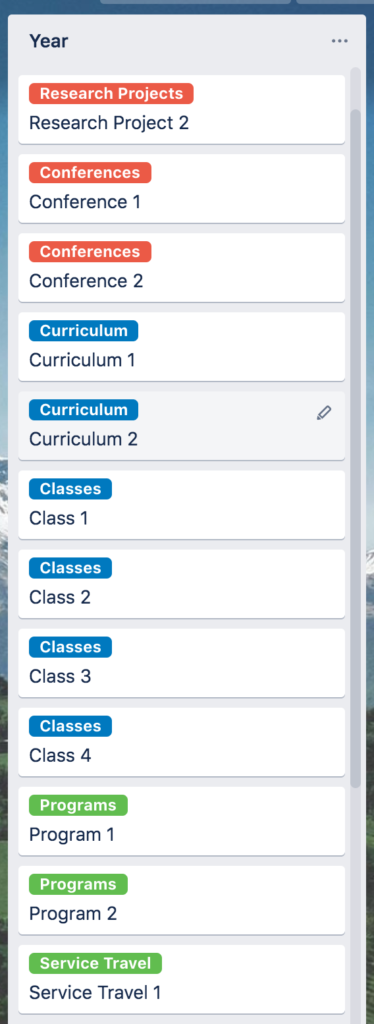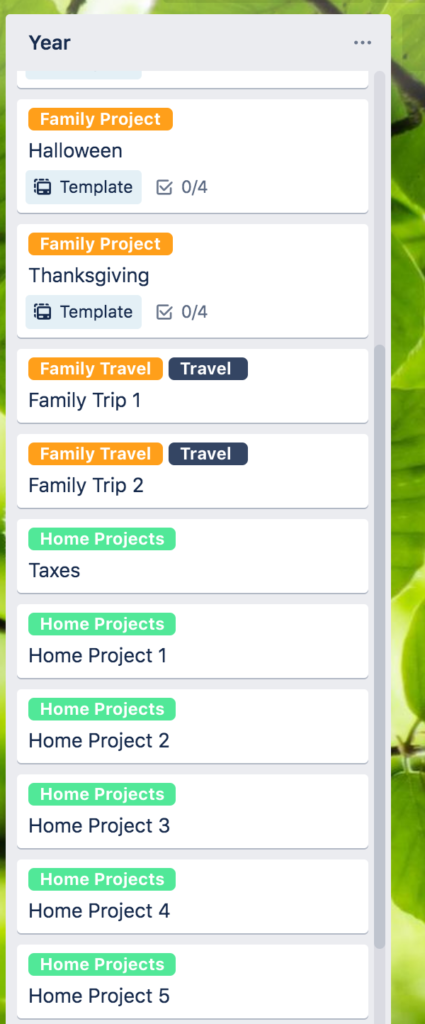In my post on using Trello for Home Management, I mentioned I had a future section of my Trello board that was likely deserving of its own post. Since 2020 is drawing to a close, and December is when I start thinking about plans for the upcoming year, I thought I would dedicate this last post of 2020 to this future planning section! Although I mentioned it in my home management post, I use the same system in the Trello boards for other areas of my life, such as work or dance, so it should be widely applicable.
My future planning section consists of 3-6 lists, depending on the time of year: Ideas, Upcoming Year, Upcoming Semesters, Year. So, in Fall 2020, it was Ideas, 2021, Year, and in December, when I started thinking about the upcoming year, it became Ideas, Spring 2021, Summer 2021, Fall 2021, 2022, Year.


Ideas
The first list is Ideas. This is fairly straightforward–ideas of projects I might want to do in this area of life, such as decorate a room (home), develop a new class (work), or plan an event for my dancers (dance). This is specifically for ideas I plan to do in the future, not in my current semester.
Year
This is probably the most unusual list, and also the most useful, as it impacts what goes on the future lists described below. This is a template that sets project limits for the number of projects I can do in this area of my life in a given year, essential for me because I always have more ideas for projects than I can actually execute. To make this list, I came up with a list of types of projects in each area of life, and then looked back at the past year* to see how many I actually did (crucially, not how many I aspired to do). For work, this list includes things like classes, conferences, curriculum development, committees, reviews, service projects, etc. For dance, it includes classes, competitions, demonstrations, judging, etc. For home, it includes holidays, home projects, trips, etc. I use the colored labels in Trello to make these different types of projects stand apart visually.
Then, I make a list that names specific projects that repeat every year (e.g. holidays, taxes) and lists the others by number (e.g. Committee 1, Committee 2, Dance Demo 1, Dance Demo 2). This becomes my project limit list, which all of my future plans have to be filtered through, as described below.



Future Year/Semesters
At the end of each year, I split up my future list into the three semesters I plan with (Spring, Summer, Fall), so moving from a 2021 list to Spring 2021, Summer 2021, Fall 2021. The 2021 list itself was a copy of the Year list described above, and as things came up for 2021 in 2020, I would just change an unspecified card (e.g. Conference 1) to a specific one (e.g. AAAL 2021). When I split up the list into semesters, I then move cards with specific dates into their semester, e.g. taxes into the Spring, or Halloween into the Fall. If a project crosses semesters (like a research project or committee), I copy it to each semester.
Next, I look at my ideas list and decide which ones will get to become specific projects to replace the generic numbered ones on my list (e.g. House Project 1 becoming set up a home gym). Crucially, the ideas have to fit into a card already on the list, I can’t add new cards to the year. I also try to leave some generic cards on for things I don’t know about yet, but might want to do later in the year. I use the labels and categories as a guide, but of course they are flexible to some degree–if I have two conferences on my Year list, but decide to only do one, I could repurpose Conference 2 for another project that takes a similar amount of time. As you might expect, this happened quite a bit for projects in 2020 that were canceled (conferences and dance events) and others that came up (virtual school supervision, achilles rehab).
Finally, I copy the Year list one more time, and rename it with the following year (in this case 2022). This way, as things come up in 2021 for 2022, I can replace the generic cards on this list with those ones.
Overall Benefits
This is fairly complicated, so why do it? For me there are several benefits. One, it lets me be realistic about what I can do in a given year, and thus choose the most important ideas or events to focus on. Two, it lets me be intentional about the balance I have between different areas of my life (home, work, dance) and types of projects within those areas (e.g. research, teaching, service). Finally, it helps me say no to areas that tend to get out of control, like service and dance volunteering, because when there are requests, and these areas are already full, I know I have to say no.
As with planning, I view this system more as a compass than a GPS, so I do adjust it as necessary rather than following it rigidly. I actually started this project limits system in late 2019 for 2020, and as you might reimagine, major readjustments were needed throughout the year. However, I think by having the overall limits set, and just adjusting across categories or areas of life, this actually helped me quite a bit in this unusual year.
Have you ever tried project limits to plan out your year, if like me you have too many ideas to execute, or work in a career where there is always more you could do? Does this seem exciting or limiting to you? Let me know in the comments!
*I did this in early 2020 looking at 2019, obviously this year has been exceptional in many ways, but if you’re trying this this year, I’d still recommend basing this list on what actually happened in 2020 rather than what you aspire to in 2021. Even if the types of projects/events are different (less travel, more virtual school), the overall number of them is probably similar.

Leave a Reply to Dominic Benton Cancel reply